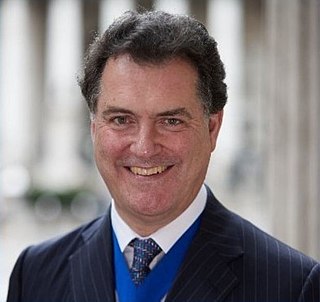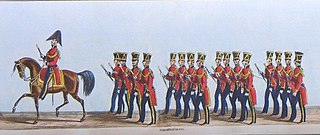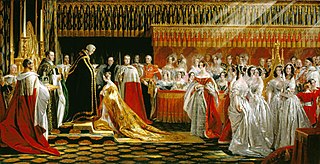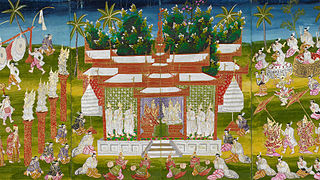
George IV was King of the United Kingdom of Great Britain and Ireland and King of Hanover from the death of his father, King George III, on 29 January 1820, until his own death ten years later. At the time of his accession to the throne, he was acting as Prince Regent, having done so since 5 February 1811, during his father's final mental illness.

The Lord Mayor of London is the mayor of the City of London and the leader of the City of London Corporation. Within the City, the Lord Mayor is accorded precedence over all individuals except the sovereign and retains various traditional powers, rights, and privileges, including the title and style The Right Honourable Lord Mayor of London.

William IV was King of the United Kingdom of Great Britain and Ireland and King of Hanover from 26 June 1830 until his death in 1837. The third son of George III, William succeeded his elder brother George IV, becoming the last king and penultimate monarch of Britain's House of Hanover.
Thomas Tusser was an English poet and farmer, best known for his instructional poem Five Hundred Points of Good Husbandry, an expanded version of his original title, A Hundreth Good Pointes of Husbandrie, first published in 1557. For Tusser the garden was the domain of the housewife, and the 1562 text expands on this theme. Scholars also consider it a text of interest for its defense of enclosures. It was among the best selling poetry books of the Elizabethan age.

Benedetto Pistrucci was an Italian gem-engraver, medallist and coin engraver, probably best known for his Saint George and the Dragon design for the British sovereign coin. Pistrucci was commissioned by the British government to create the large Waterloo Medal, a project which took him thirty years to complete.

The Most Honourable Order of the Bath is a British order of chivalry founded by George I on 18 May 1725. The name derives from the elaborate medieval ceremony for appointing a knight, which involved bathing as one of its elements. The knights so created were known as "Knights of the Bath". George I "erected the Knights of the Bath into a regular Military Order". He did not revive the Order of the Bath, since it had never previously existed as an Order, in the sense of a body of knights who were governed by a set of statutes and whose numbers were replenished when vacancies occurred.

The Crown Jewels of the United Kingdom, originally the Crown Jewels of England, are a collection of royal ceremonial objects kept in the Tower of London which include the coronation regalia and vestments worn by British monarchs.

St Edward's Crown is the centrepiece of the Crown Jewels of the United Kingdom. Named after Saint Edward the Confessor, versions of the crown have been traditionally used to crown English and British monarchs at their coronations since the 13th century.

The Honours of Scotland, informally known as the Scottish Crown Jewels, are regalia that were worn by Scottish kings and queens at their coronations. Kept in Edinburgh Castle, they date from the 15th and 16th centuries, and are the oldest surviving set of crown jewels in the British Isles.

The coronation of the monarch of the United Kingdom is a ceremony in which they are formally invested with regalia and crowned at Westminster Abbey. It corresponds to the coronations that formerly took place in other European monarchies, all of which have abandoned coronations in favour of inauguration or enthronement ceremonies. A coronation is a symbolic formality and does not signify the official beginning of the monarch's reign; de jure and de facto his or her reign commences from the moment the preceding monarch dies, maintaining the legal continuity of the monarchy.

Sir Norman Bishop Hartnell, KCVO was a leading British fashion designer, best known for his work for the ladies of the royal family. Hartnell gained the Royal Warrant as Dressmaker to Queen Elizabeth in 1940, and Royal Warrant as Dressmaker to Queen Elizabeth II in 1957. Princess Beatrice also wore a dress designed for Queen Elizabeth by Hartnell for her wedding in 2020.

Ascot Racecourse is a dual-purpose British racecourse, located in Ascot, Berkshire, England, which is used for thoroughbred horse racing. It hosts 13 of Britain's 36 annual Flat Group 1 horse races and three Grade 1 Jumps races.

A Page of Honour is a ceremonial position in the Royal Household of the Sovereign of the United Kingdom. It requires attendance on state occasions, but does not now involve the daily duties which were once attached to the office of page. The only physical activity involved is usually carrying the long train of the Queen's robes.
The feudal holder of the Manor of Scrivelsby in Lincolnshire, England, has, since the Norman Conquest in 1066, held the manor from the Crown by grand serjeanty of being The Honourable The King's/Queen's Champion. Such person is also the Standard Bearer of England. The current King's Champion is a member of the Dymoke family, which has included many Champions.

The Knight Marshal is a former office in the British Royal Household established by King Henry III in 1236. The position later became a Deputy to the Earl Marshal from the reign of King Henry VIII until the office was abolished in 1846.

The coronation of Elizabeth II took place on 2 June 1953 at Westminster Abbey in London. She acceded to the throne at the age of 25 upon the death of her father, George VI, on 6 February 1952, being proclaimed queen by her privy and executive councils shortly afterwards. The coronation was held more than one year later because of the tradition of allowing an appropriate length of time to pass after a monarch dies before holding such festivals. It also gave the planning committees adequate time to make preparations for the ceremony. During the service, Elizabeth took an oath, was anointed with holy oil, was invested with robes and regalia, and was crowned queen of the United Kingdom, Canada, Australia, New Zealand, South Africa, Pakistan, and Ceylon.

Queen Elizabeth II's coronation took place on 2 June 1953. Ordered in October 1952, the gown took eight months of research, design, workmanship, and intricate embroidery to complete. It featured the floral emblems of the countries of the United Kingdom and those of the other states within the Commonwealth of Nations, including the English Tudor rose, Scots thistle, Welsh leek, Irish shamrock, Canadian maple leaf, Australian wattle, New Zealand silver fern, South African protea, Indian lotus flower for India, the Lotus flower of Ceylon, and Pakistan's wheat, cotton, and jute.

The coronation of Queen Victoria took place on Thursday, 28 June 1838, just over a year after she succeeded to the throne of the United Kingdom at the age of 18. The ceremony was held in Westminster Abbey after a public procession through the streets from Buckingham Palace, to which the Queen returned later as part of a second procession.

The coronation (Rajabhiseka) was one of the most important rituals of the Burmese Kingdom. Similar to the neighboring countries Thailand, Cambodia and Laos the ceremony is largely influenced by the Indian Hindu Culture. Most of them were typically held in the Burmese month of Kason, but did not necessarily occur during the beginning of a reign. The Sasanalinkaya states that Bodawpaya, like his father, was crowned only after establishing control over the kingdom's administration and purifying the religious institutions. The coronation is then followed by the assumption of the Royal Residence. Following are the rituals done during the coronation of King Mindon on 14 May 1857.

The coronation of George IV as king of the United Kingdom took place at Westminster Abbey, London, on 19 July 1821. Originally scheduled for 1 August of the previous year, the ceremony had been postponed due to the parliamentary proceedings of George's estranged wife, Caroline of Brunswick; because these failed to deprive Queen Caroline of her titles and obtain a divorce from the king, she was excluded from the ceremony. In accordance with George's lavish personal tastes, the coronation was the most extravagant ever staged and a number of the traditional elements of the ceremonial were conducted for the last time.
















